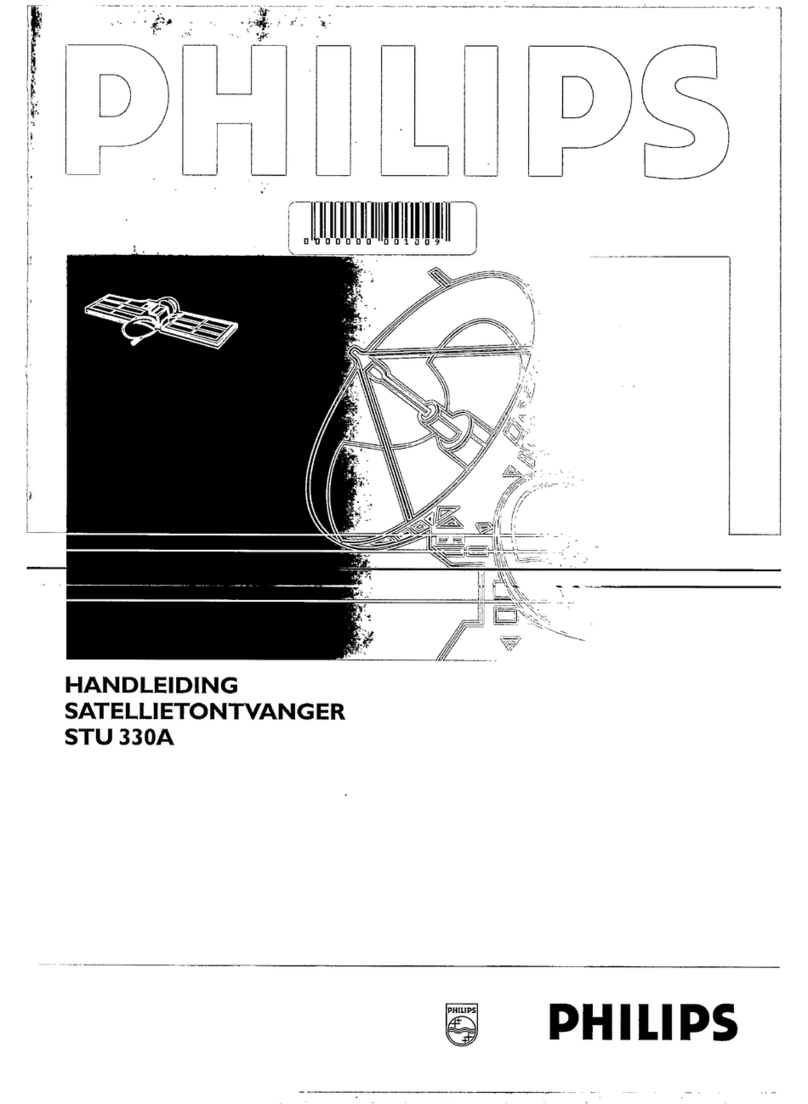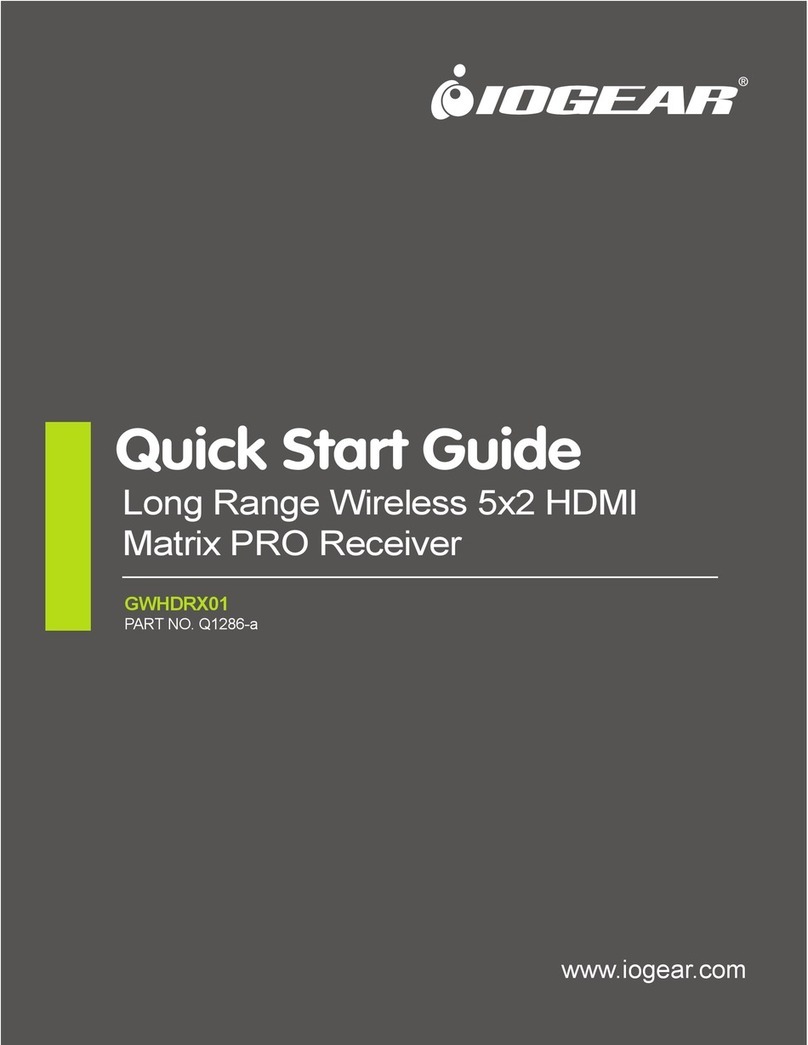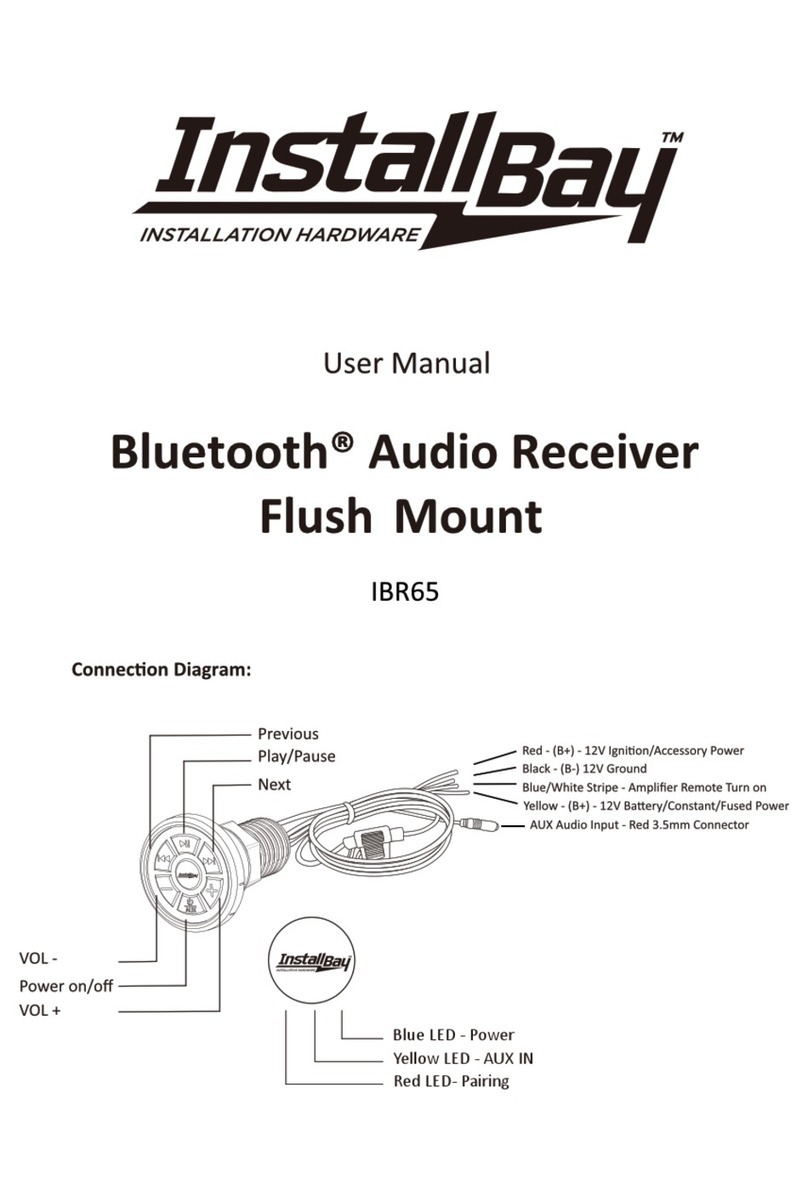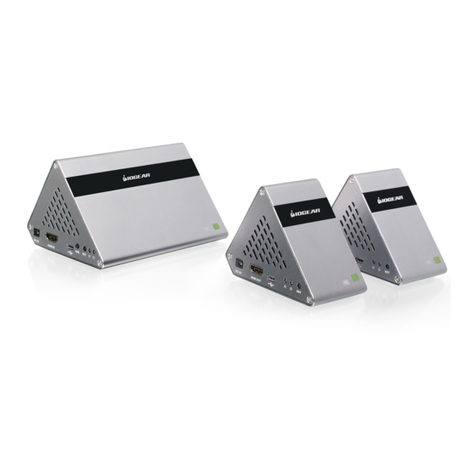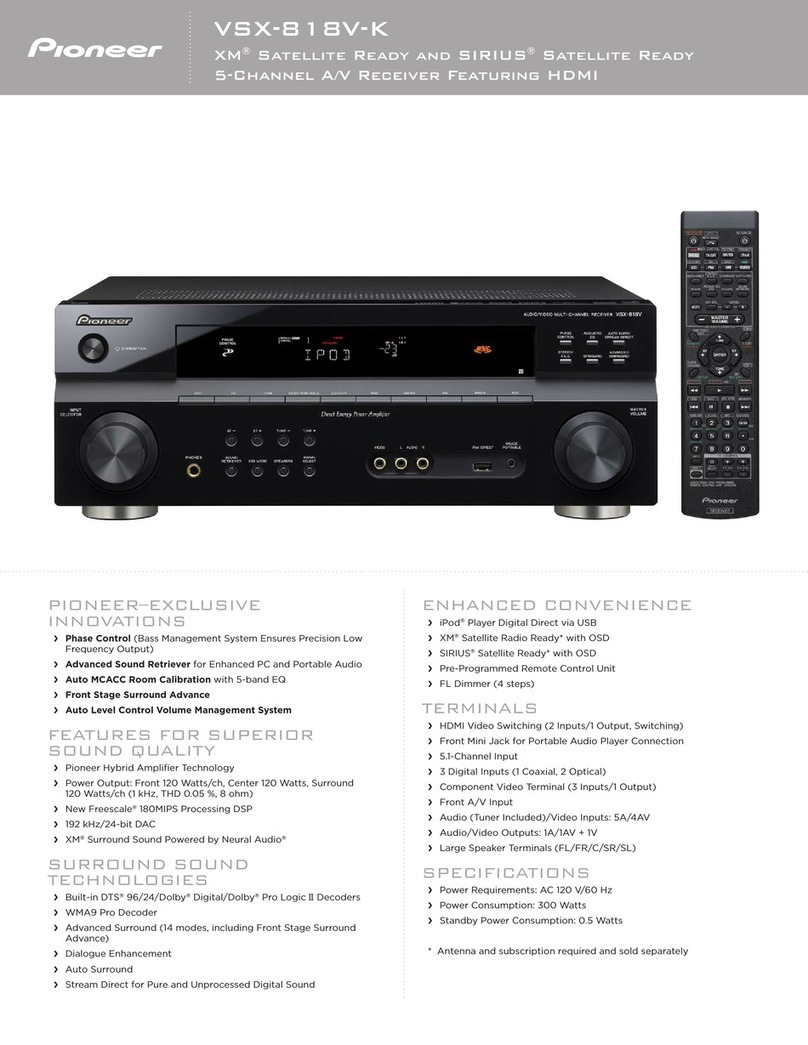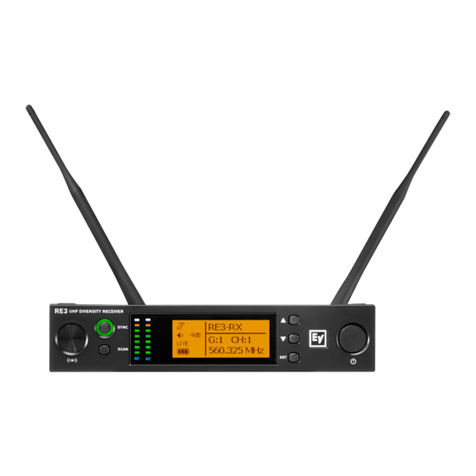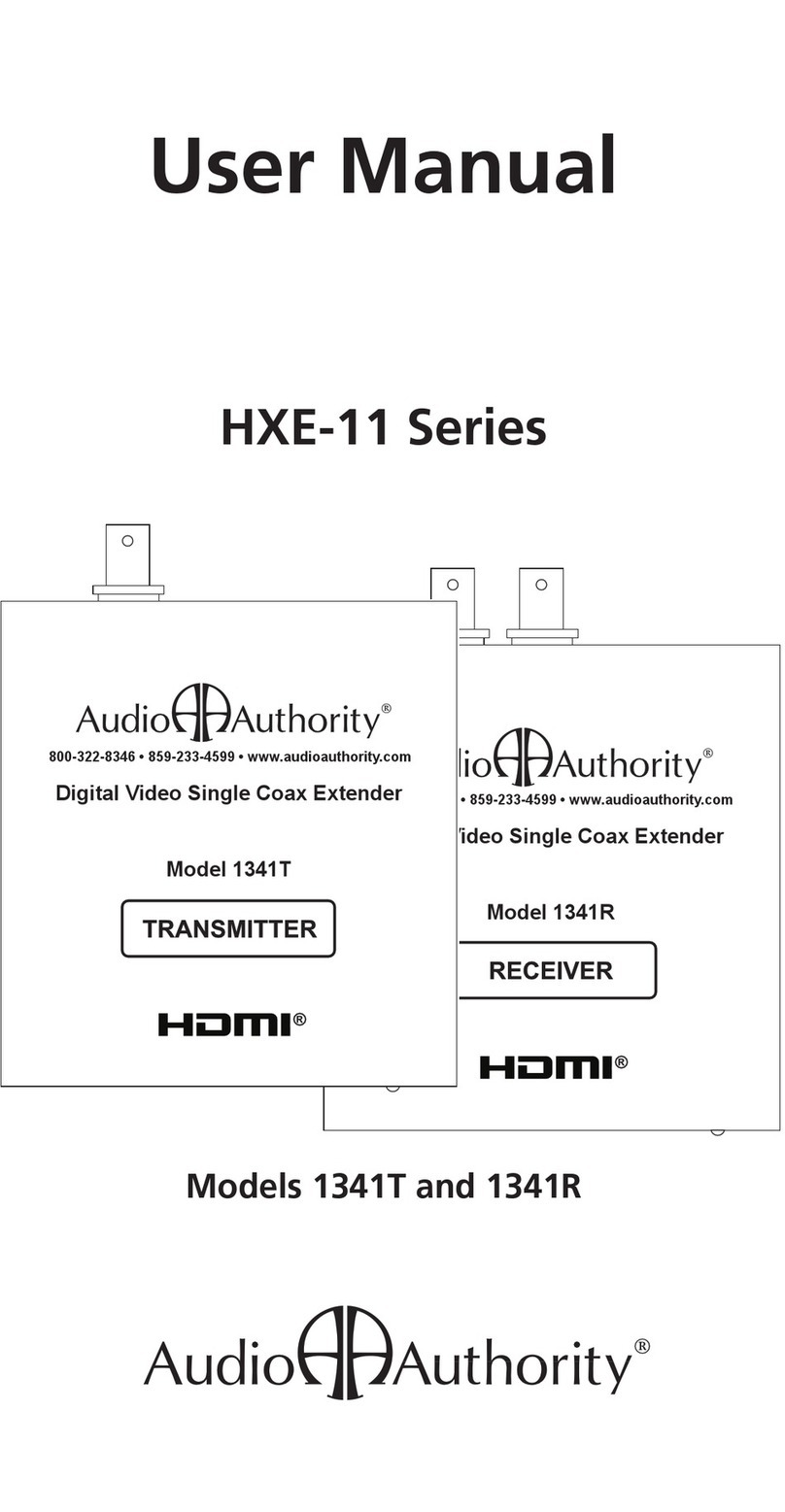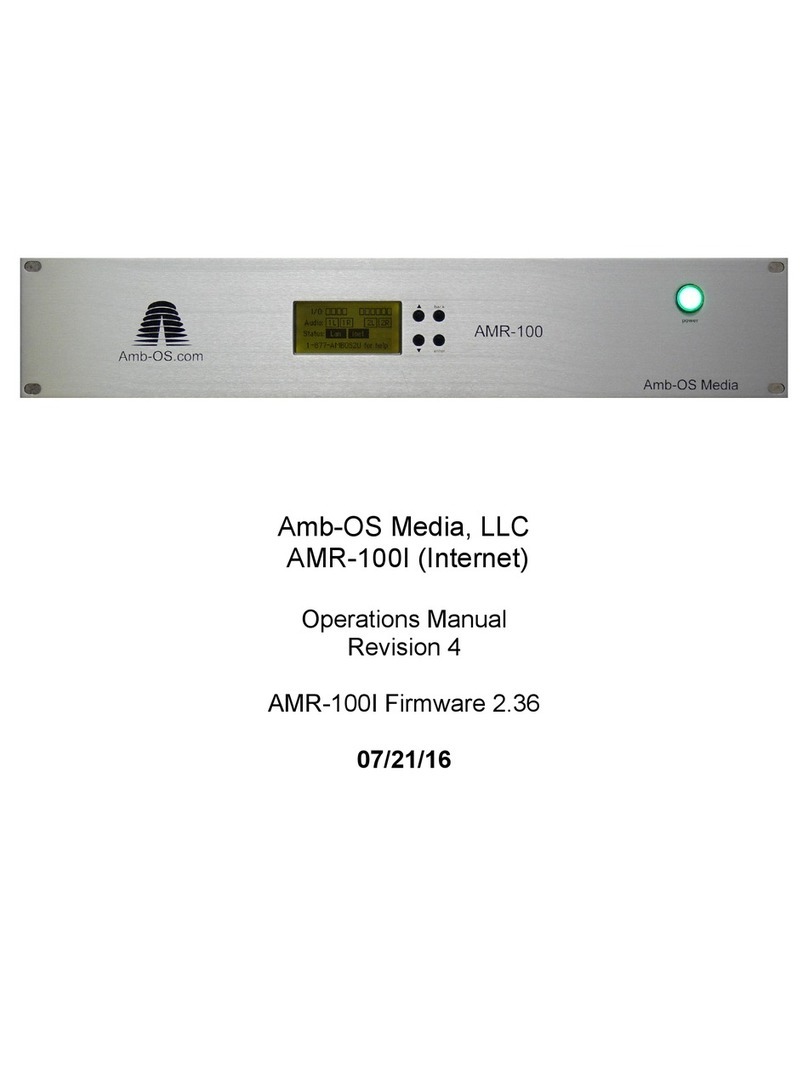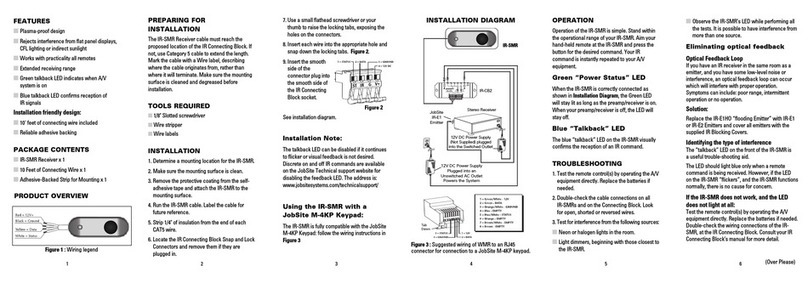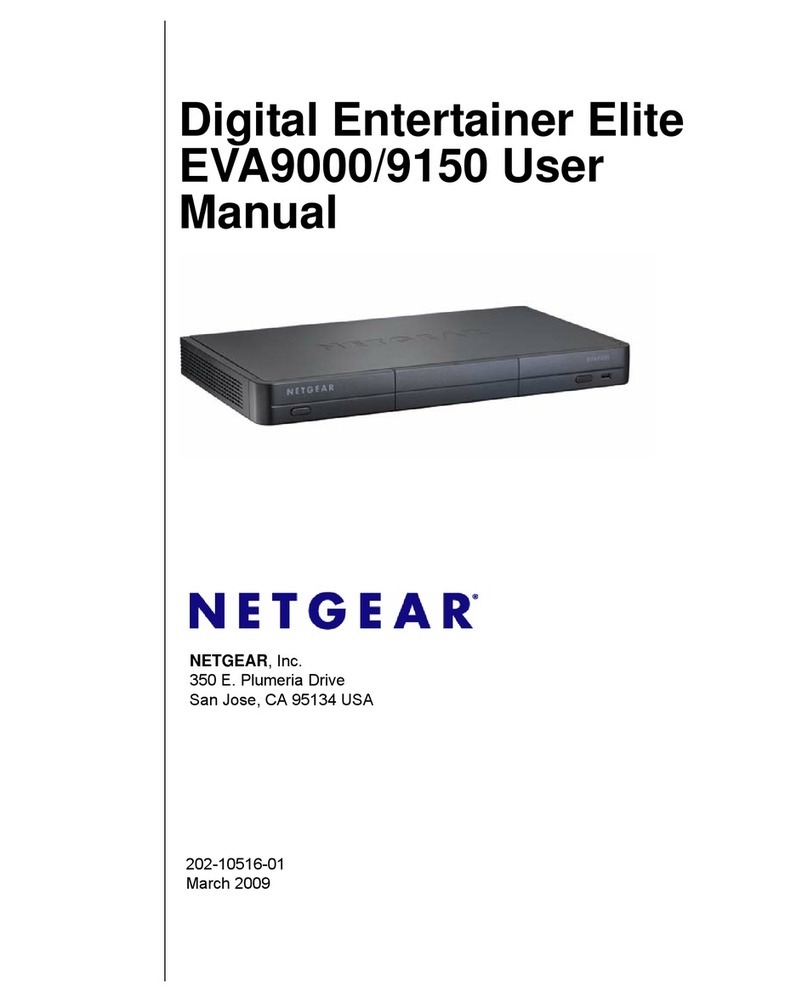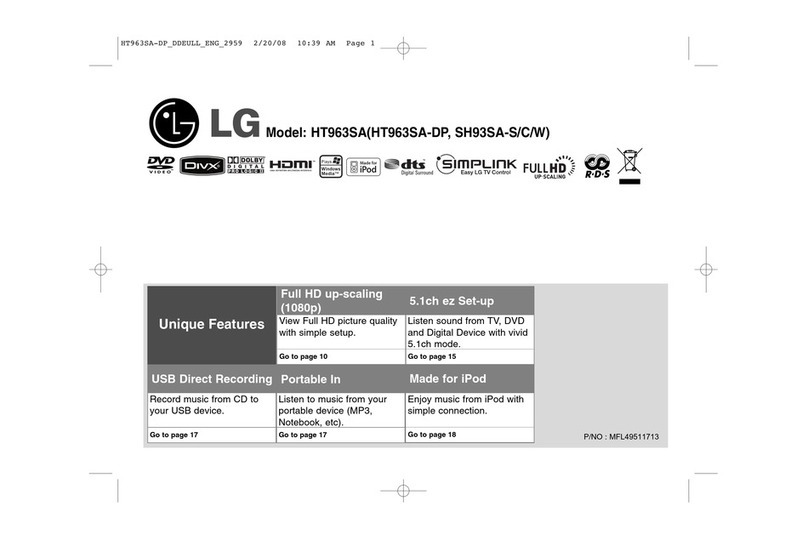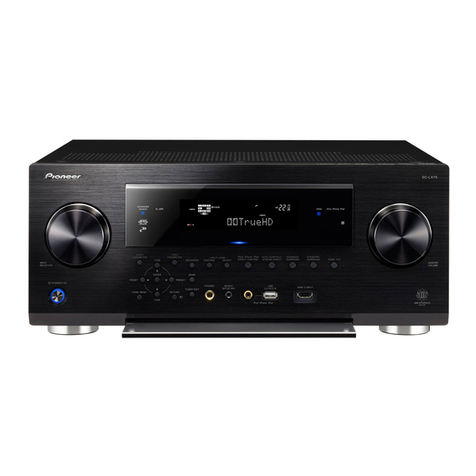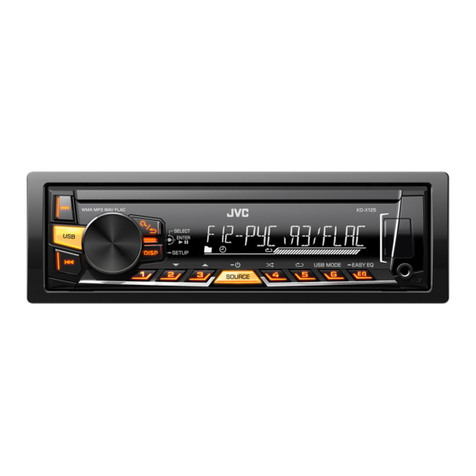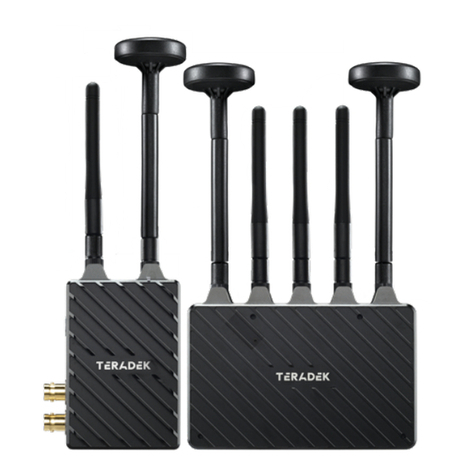IMG STAGE LINE ATS-10R User manual

BEDIENUNGSANLEITUNG • INSTRUCTION MANUAL
MODE D’EMPLOI • ISTRUZIONI PER L’USO • GEBRUIKSAANWIJZING
MANUAL DE INSTRUCCIONES • INSTRUKCJA OBSŁUGI
ATS-10R Best.-Nr. 24.3500
EMPFÄNGER FÜR 16-KANAL-AUDIO-
ÜBERTRAGUNGSSYSTEM
RECEIVER FOR 16-CHANNEL AUDIO TRANSMISSION SYSTEM
RÉCEPTEUR POUR SYSTÈME DE TRANSMISSION AUDIO 16 CANAUX
RICEVITORE PER SISTEMA DI TRASMISSIONE AUDIO A 16 CANALI
863–865MHz

2wwwwww..iimmggssttaaggeelliinnee..ccoomm
®
Bevor Sie einschalten ...
Wir wünschen Ihnen viel Spaß mit
Ihrem neuen Gerät von „img Stage
Line“. Bitte lesen Sie diese Bedie-
nungsanleitung vor dem Gebrauch
gründlich durch und heben Sie sie
für ein späteres Nachlesen auf.
Der deutsche Text beginnt auf Seite 4.
Before you switch on ...
We wish you much pleasure with your
new “img Stage Line” unit. Please
read these operating instructions
carefully prior to operating the unit
and keep them for later use.
The English text starts on page 6.
Avant toute utilisation ...
Nous vous souhaitons beaucoup de
plaisir à utiliser cet appareil “img
Stage Line”. Veuillez lire entièrement
cette notice d’utilisation avant la mise
en service et conservez-la pour une
consultation ultérieure.
La version française commence à la
page 8.
Prima di accendere ...
Vi auguriamo buon divertimento con il
Vostro nuovo apparecchio “img Stage
Line”. Vi preghiamo di leggere atten-
tamente le presenti istruzioni prima
della messa in funzione e di conser-
varle per un uso futuro.
Il testo italiano comincia a pagina 10.
Alvorens u inschakelt ...
Wij wensen u veel plezier met uw
nieuw toestel van “img Stage Line”.
Lees deze bedieningshandleiding
grondig door, alvorens het toestel in
gebruik te nemen, en bewaar ze voor
latere raadpleging.
De Nederlandse tekst begint op pa-
gina 12.
Przed Uruchomieniem ...
Życzymy zadowolenia z nowego
produktu “img Stage Line”. Prosimy
o uważne przeczytanie poniższej
instrukcji przed użyciem urządzenia.
Tekst polski zaczyna si na stronie 16.
D
A
CH
F
B
CH
NL
B
GB
I
PL
Antes de la utilización … ...
Le deseamos una buena utilización
para su nuevo aparato “img Stage
Line”. Por favor, lea este manual de
instrucciones detalladamente antes
de hacer funcionar la unidad y guár-
delo para una utilización posterior.
El texto en español empieza en la
página 14.
E

ANT. ON OFF BATT.
STAND BY
EAR.
LOW
3
56 7 8
➁
ATS-10R
ATS-10R RECEIVER
FREQUENCY 863 - 865 MHz
2 x 1.2 V NiMH rech. battery AA size
OPEN
CHANNEL
SELECT
4
C
08
2
6
A
E
➂
2
1
4
3
9
11
10
➀

Bitte klappen Sie die Seite 3 heraus. Sie
sehen dann immer die beschriebenen Be-
dienelemente und Anschlüsse.
1 Übersicht der Bedienelemente und
Anschlüsse
1Antenne
2Lautstärkeregler
3Kontakte zum Aufladen der eingesetzten
Akkus über die als Zubehör erhältliche
Ladestation ATS-10PS
4eingebauter Lautsprecher
5Gewindebuchse zum Aufschrauben der
Antenne [siehe Position (1), Abb. 1]
63,5-mm-Klinkenbuchse zum Anschließen
des mitgelieferten Ohrhörers
7Schiebeschalter zum Ein-/Ausschalten
Schalter links (ON)
Gerät eingeschaltet und betriebsbereit
Schalter in der Mitte (STAND BY)
Gerät im Stand-by-Modus, d.h. es ist
eingeschaltet, aber der Ton wird nicht
über Lautsprecher oder Ohrhörer wie-
dergegeben.
Schalter rechts (OFF)
Gerät ausgeschaltet
8LED-Statusanzeige
aim Normalbetrieb
Nach dem Ein-/Ausschalten blitzt die
LED einmal kurz rot auf. Im Betrieb
leuchtet sie permanent grün:
hell, wenn ein Funksignal vom Sen-
der empfangen wird,
schwach, wenn kein Funksignal vom
Sender empfangen wird.
bbei geringer Akku-/Batterieladung
Leuchtet die LED permanent rot, sind
dieAkkus bzw. Batterien fast erschöpft.
9Drehschalter zur Auswahl des Übertra-
gungskanals (16 Schalterstellungen)
10 Gürtelklemme
11 Batteriefachdeckel
2 Wichtige Hinweise für den
Gebrauch
Das Gerät entspricht allen erforderlichen
Richtlinien der EU und ist deshalb mit
gekennzeichnet.
●Das Gerät ist nur zur Verwendung im
Innenbereich geeignet. Schützen Sie es
vor Feuchtigkeit und Hitze (zulässiger Ein-
satztemperaturbereich 0–40°C).
●Verwenden Sie für die Reinigung nur ein
trockenes, weiches Tuch, niemals Chemi-
kalien oder Wasser.
●Setzen Sie immer zwei Akkus bzw. Batte-
rien des gleichen Typs ein.
●Nehmen Sie bei längerem Nichtgebrauch
(z.B. länger als eine Woche) die Akkus/
Batterien heraus. So bleibt das Gerät bei
einem eventuellen Auslaufen der Akkus/
Batterien unbeschädigt.
●Wird das Gerät zweckentfremdet, falsch
bedient oder nicht fachgerecht repariert,
kann keine Haftung für daraus resultieren-
de Sach- oder Personenschäden und
keine Garantie für das Gerät übernommen
werden.
3 Einsatzmöglichkeiten
Mit einem oder mehreren Empfänger/n ATS-
10R und einem Sender derATS-10-Serie lässt
sich ein drahtloses 16-Kanal-Audio-Übertra-
gungssystem aufbauen, das im Frequenzbe-
reich 863–865MHz arbeitet. Das System eig-
net sich speziell für Anwendungen, bei denen
das Signal einer Tonquelle mehreren Perso-
nen zugeführt werden soll, z.B. für Gruppen-
führungen oder mehrsprachige Vorträge.
Soll das Gerät endgültig aus dem Betrieb
genommen werden, übergeben Sie es zur
umweltgerechten Entsorgung einem ört-
lichen Recyclingbetrieb.
Werfen Sie verbrauchte Batterien/defekte Akkus
nicht in den Hausmüll, sondern geben Sie sie nur in
den Sondermüll (z.B. Sammelbehälter bei Ihrem Ein-
zelhändler).
4
D
A
CH

4 Stromversorgung
Der Empfänger wird über die zwei mitgelie-
ferten NiMH-Akkus gespeist. Als Zubehör ist
aus dem Programm von „img Stage Line“ die
Ladestation ATS-10PS zum bequemen und
schnellen Aufladen der Akkus erhältlich.
Anstelle der Akkus können auch zwei
nicht wiederaufladbare 1,5-V-Batterien der
Größe Mignon (AA) verwendet werden.
1) Die geriffelte Fläche auf dem Batterie-
fachdeckel (11) leicht eindrücken und den
Deckel gleichzeitig nach unten abziehen.
2) Die Akkus bzw. Batterien, mit den Plus-
und Minusanschlüssen wie im Fach auf-
gedruckt, einsetzen.
3) Den Batteriefachdeckel wieder aufsetzen
und einrasten.
5 Inbetriebnahme
1) Die beiliegende Antenne (1) in die Ge-
windebuchse ANT. (5) schrauben.
2) Die Tonwiedergabe kann über den einge-
bauten Lautsprecher (4) oder den mitge-
lieferten Ohrhörer erfolgen. Bei Verwen-
dung des Ohrhörers diesen an die Buchse
EAR. (6) anschließen (der Lautsprecher
ist damit abgeschaltet) und den Hörer an
der Ohrmuschel befestigen.
3) Den Kanalwahlschalter CHANNEL SE-
LECT (9) mit einem schmalen Gegen-
stand (z.B. Schraubendreher) auf die glei-
che Position stellen, auf welcher der
Kanalwahlschalter am Sender steht.
4) Den Empfänger mit der Klemme (10) an
der Kleidung befestigen, z.B. am Gürtel.
5) Den Sender einschalten.
6) Zum Einschalten des Empfängers den
Schiebeschalter (7) nach links auf ON
stellen. (In der Mittelstellung STAND BYist
der Empfänger auch eingeschaltet, aber
stumm d.h. kein Ton wird über Lautspre-
cher oder Ohrhörer wiedergegeben.)
Nach dem Einschalten blitzt die LED
BATT. LOW (8) kurz rot auf und leuchtet
dann permanent grün. (Leuchtet sie nur
schwach grün, wird kein Funksignal emp-
fangen, d.h. der Sender ist ausgeschaltet
oder auf einen anderen Kanal als der
Empfänger eingestellt.) Leuchtet die LED
permanent rot, sind die Akkus/Batterien
fast erschöpft und müssen aufgeladen
bzw. ersetzt werden.
7) Nachdem am Sender die Lautstärke für
das Audiosignal eingestellt wurde, mit
dem Regler VOL (2) die gewünschte Wie-
dergabelautstärke einstellen.
8) Zum Ausschalten des Empfängers den
Schiebeschalter (7) nach rechts auf OFF
stellen: Die LED BATT. LOW (8) blitzt kurz
rot auf und erlischt.
9) Bei Störungen oder schlechtem Empfang
siehe die entsprechenden Hinweise in der
Bedienungsanleitung des Senders.
6 Technische Daten
Gerätetyp: . . . . . . . . . 16-Kanal-PLL-Emp-
fänger für drahtlose
Audio-Übertragung
Funkfrequenzbereich: 863–865MHz
Einsatztemperatur: . . 0–40°C
Stromversorgung: . . . über die zwei mitge-
lieferten 1,2-V-NiMH-
Akkus oder über
zwei 1,5-V-Batterien,
Größe Mignon (AA)
Abmessungen: . . . . . 92 x 65 x 25mm
Gewicht: . . . . . . . . . . 80g (ohneAkkus)
Änderungen vorbehalten.
5
D
A
CH
Diese Bedienungsanleitung ist urheberrechtlich für MONACOR®INTERNATIONAL GmbH & Co. KG
geschützt. Eine Reproduktion für eigene kommerzielle Zwecke – auch auszugsweise – ist untersagt.

Please unfold page 3. Then you can always
see the operating elements and connec-
tions described.
1 Operating Elements and
Connections
1Antenna
2Volume control
3Contacts for charging the inserted re-
chargeable batteries via the charging sta-
tion ATS-10PS available as an accessory
4Integrated speaker
5Threaded jack for screwing on the anten-
na [see position (1), fig. 1]
63.5mm jack for connecting the supplied
earphone
7Sliding switch for switching on or off
switch at the left stop (ON)
unitswitched on and ready for operation
switch in mid-position (STAND BY)
unit in stand-by mode, i.e. it is switched
on but the sound is not reproduced via
speaker or earphone
switch at the right stop (OFF)
unit switched off
8Status LED
anormal operation:
After switching on or off, the LED
shortly flashes red once. During opera-
tion, it permanently shows green:
LED shows a bright green light if a
radio signal is received from the
transmitter,
LED shows a dim green light if no
radio signal is received from the
transmitter.
blow batteries:
If the LED permanently shows red, the
(rechargeable) batteries are almost
exhausted.
9Selector switch for the transmission
channel (16 positions)
10 Belt clip
11 Battery compartment cover
2 Important Notes
The unit corresponds to all required directives
of the EU and is therefore marked with .
●The unit is suitable for indoor use only. Pro-
tect it against humidity and heat (admissi-
ble ambient temperature range 0–40°C).
●For cleaning only use a dry, soft cloth;
never use chemicals or water.
●Always insert two (rechargeable) batteries
of the same type.
●If the unit is not used for a longer time (e.g.
for more than a week), it is recommended
to remove the (rechargeable) batteries to
prevent damage to the unit in case of bat-
tery leakage.
●No guarantee claims for the unit and no lia-
bility for any resulting personal damage or
material damage will be accepted if the unit
is used for other purposes than originally
intended, if it is not correctly operated or
not repaired in an expert way.
3 Applications
In combination with one receiver or several
receivers of the typeATS-10R and a transmit-
ter of the ATS-10 series, a wireless 16-chan-
nel audio transmission system operating in
the frequency range of 863–865MHz can be
set up. The system is ideally suited for
applications where the signal of an audio
source is to be fed to several persons, e.g.
guided tours or multilingual lectures.
If the unit is to be put out of operation de-
finitively, take it to a local recycling plant for
a disposal which is not harmful to the en-
vironment.
Never throw exhausted batteries or defective re-
chargeable batteries into the household rubbish:
Always take them to a special waste disposal (e.g.
collecting container at your retailer).
6
GB

4 Power Supply
The receiver is supplied with power via the
two supplied rechargeable NiMH batteries.
For fast and convenient charging of the bat-
teries, the charging station ATS-10PS from
the “img Stage Line” range is available as an
accessory.
Instead of the rechargeable batteries it is
also possible to use two non-rechargeable
1.5V batteries of sizeAA.
1) Slightly press the grooves on the battery
compartment cover (11) while pulling the
cover downwards at the same time.
2) Insert the (rechargeable) batteries with
the positive and negative connections as
printed in the compartment.
3) Replace the cover and let it lock into place.
5 Operation
1) Screw the supplied antenna (1) into the
threaded jack ANT. (5).
2) The sound can be reproduced via the inte-
grated speaker (4) or via the supplied ear-
phone. When using the earphone, con-
nect it to the jack EAR. (6) [the speaker is
switched off in this case] and attach the
earphone to your ear.
3) Use a narrow object (e.g. screwdriver) to
set the channel selector switch CHANNEL
SELECT (9) to the same position as the
channel selector switch on the transmitter.
4) Use the clip (10) to fasten the receiver to
your clothes, e.g. belt.
5) Switch on the transmitter.
6) To switch on the receiver, set the sliding
switch (7) to the left stop to ON. (In the
mid-position STAND BY, the receiver is
also switched on but it is mute, i.e. no
sound is reproduced via the speaker or
earphone.)
After switching on, the LED BATT. LOW
(8) shortly flashes red before permanently
showing green. (If the LED shows a
dim green light only, no radio signal is
received, i.e. the transmitter is switched
off or set to a different channel than the
receiver.) If the LED permanently shows
red, the (rechargeable) batteries are al-
most exhausted and must be recharged
or replaced.
7) After the volume for the audio signal has
been adjusted on the transmitter, adjust
the desired reproduction volume with the
control VOL (2).
8) To switch off the receiver, set the sliding
switch (7) to the right stop to OFF: The
LED BATT. LOW (8) shortly flashes red
before it is extinguished.
9) In case of problems caused by interfer-
ence or poor reception see the corre-
sponding notes in the instruction manual
of the transmitter.
6 Specifications
Type of unit: . . . . . . . . 16-channel PLL
receiver for wireless
audio transmission
Radio frequency
range: . . . . . . . . . . . . 863–865MHz
Ambient temperature: 0–40°C
Power supply: . . . . . . via the two supplied
1.2V rechargeable
NiMH batteries or via
two 1.5V batteries of
size AA
Dimensions: . . . . . . . 92 x 65 x 25mm
Weight: . . . . . . . . . . . 80g (without re-
chargeable batteries)
Subject to technical modification.
7
GB
All rights reserved by MONACOR®INTERNATIONAL GmbH & Co. KG. No part of this instruction
manual may be reproduced in any form or by any means for any commercial use.

Ouvrez le présent livret page 3 de manière
à visualiser les éléments et branche-
ments.
1 Eléments et branchements
1Antenne
2Potentiomètre de réglage de volume
3Contacts pour charger les accumulateurs
intégrés via la station de chargeATS-10PS
disponible comme accessoire
4Haut-parleur intégré
5Prise filetée pour visser l’antenne [voir
position (1), schéma 1]
6Prise jack 3,5 pour brancher l’écouteur
livré
7Interrupteur pour marche/arrêt
interrupteur à gauche (ON) :
appareil allumé et prêt à fonctionner
interrupteur au milieu (STAND BY)
appareil en mode stand-by, c’est-à-dire
qu’il est allumé mais le son n’est pas
restitué par le haut-parleur ou l’écouteur
interrupteur à droite (OFF)
l’appareil est éteint
8LED témoin d’état
aen mode normal :
après la mise sous tension/l’arrêt, la
LED brille brièvement une fois en
rouge ; pendant le fonctionnement elle
brille tout le temps en vert :
clair : si un signal radio de l’émet-
teur est reçu
faible : si aucun signal radio de
l’émetteur n’est reçu
ben cas de charge faible des accus/bat-
teries
la LED brille en permanence en rouge
si les accumulateurs/batteries sont
presque vides
9Sélecteur rotatif du canal de transmission
(16 positions)
10 Clip de ceinture
11 Couvercle compartiment batterie
2 Conseils importants d’utilisation
L’appareil répond à toutes les directives né-
cessaires de l’Union Européenne et porte
donc le symbole .
●L’appareil n’est conçu que pour une utilisa-
tion en intérieur. Protégez-le de l’humidité
et de la chaleur (plage de température de
fonctionnement autorisée : 0–40°C).
●Pour le nettoyer, utilisez uniquement un
chiffon sec et doux, en aucun cas de pro-
duits chimiques ou d’eau.
●Placez toujours deux accumulateurs ou
batteries de même type.
●En cas de non utilisation prolongée (p.ex.
supérieure à une semaine), retirez les
accumulateurs/batteries. On évite ainsi
que l’appareil ne soit endommagé si les
accumulateurs/batteries venaient à couler.
●Nous déclinons toute responsabilité en cas
de dommages corporels ou matériels
résultants si l’appareil est utilisé dans un
but autre que celui pour lequel il a été
conçu, s’il n’est pas correctement utilisé ou
s’il n’est pas réparé par une personne
habilitée ; de même, la garantie deviendrait
caduque.
3 Possibilités d’utilisation
Avec un ou plusieurs récepteurs ATS-10R et
un émetteur de la série ATS-10, il est possi-
ble de constituer un système de transmission
audio 16 canaux sans fil, fonctionnant dans la
plage de fréquence 863–865MHz. Le sys-
tème est particulièrement bien adapté à des
utilisations où le signal d’une source audio
doit être attribué à plusieurs personnes p.ex.
Lorsque l’appareil est définitivement retiré
du marché, vous devez le déposer dans
une usine de recyclage de proximité pour
contribuer à son élimination non polluante.
Ne jetez pas les batteries usagées/accumulateurs
défectueux dans la poubelle domestique mais dépo-
sez-les dans un container spécifique ou reportez-les
à votre revendeur.
8
F
B
CH

pour des visites de groupes ou des conféren-
ces multilingues.
4 Alimentation
Le récepteur est alimenté par deux accumula-
teurs NiMH livrés. Comme accessoire, la sta-
tion de charge ATS-10PS de la gamme “img
Stage Line” est disponible pour une charge
rapide et confortable des accumulateurs.
Ala place des accumulateurs, il est égale-
ment possible d’utiliser deux batteries 1,5V
non rechargeables de type R6.
1) Enfoncez légèrement la surface striée du
couvercle du compartiment batterie (11)
et simultanément, poussez vers le bas le
couvercle.
2) Insérez les accumulateurs ou batteries en
respectant les bornes plus et moins
comme indiqué dans le compartiment.
3) Replacez le couvercle du compartiment
batterie et enclenchez-le.
5 Fonctionnement
1) Vissez l’antenne livrée (1) dans la prise
filetée ANT. (5).
2) La restitution audio peut s’effectuer via le
haut-parleur intégré (4) ou via l’écouteur
livré. Si vous utilisez l’écouteur reliez-le à
la prise EAR. (6) [le haut-parleur est alors
déconnecté] et fixez l’écouteur sur l’oreille.
3) Mettez le sélecteur de canal CHANNEL
SELECT (9) avec un objet étroit (p.ex.
tournevis) sur la même position que celle
du sélecteur de canal sur l’émetteur.
4) Fixez le récepteur avec la pince (10) sur
un vêtement, par exemple à la ceinture.
5) Allumez l’émetteur.
6) Pour allumer le récepteur, mettez le sélec-
teur (7) à gauche sur ON (en position mé-
diane STAND BY, le récepteur est égale-
ment allumé mais il est muet, c’est-à-dire
qu’aucun son n’est restitué par le haut-
parleur ou l’écouteur).
Après la mise sous tension, la LED
BATT. LOW (8) brille brièvement en rouge
puis en permanence en vert. (Si elle ne
brille qu’en vert de manière faible, aucun
signal radio n’est reçu, c’est-à-dire que
l’émetteur est éteint ou réglé sur un autre
canal que le récepteur). Si la LED brille
tout le temps en rouge, les accumulateurs/
batteries sont presque vides et doivent être
chargés ou remplacés.
7) Une fois le volume pour le signal audio
réglé sur l’émetteur, réglez avec le poten-
tiomètre VOL (2) le volume de restitution
souhaité.
8) Pour éteindre le récepteur, mettez le sé-
lecteur (7) sur OFF à droite : la LED BATT.
LOW (8) brille brièvement en rouge puis
s’éteint.
9) En cas de perturbations ou de mauvaise
réception, reportez-vous aux conseils
idoines dans la notice d’utilisation de
l’émetteur.
6 Caractéristiques techniques
Type appareil : . . . . . . récepteur PLL 16 ca-
naux pour transmis-
sion audio sans fil
Plage de fréquence
radio : . . . . . . . . . . . . 863–865MHz
Température fonc. : . . 0–40°C
Alimentation : . . . . . . par 2 accumulateurs
1,2V NiMH livrés ou
par 2 batteries 1,5V
de type R6
Dimensions : . . . . . . . 92 x 65 x 25mm
Poids : . . . . . . . . . . . . 80g (sans accus)
Tout droit de modification réservé.
9
F
B
CH
Notice d'utilisation protégée par le copyright de MONACOR®INTERNATIONAL GmbH & Co. KG.
Toute reproduction même partielle à des fins commerciales est interdite.

Vi preghiamo di aprire completamente la
pagina 3. Così vedrete sempre gli elementi
di comando e i collegamenti descritti.
1 Elementi di comando e
collegamenti
1Antenna
2Regolatore volume
3Contatti per caricare le batterie ricaricabili
per mezzo della stazione di carica ATS-
10PS opzionale
4Altoparlante integrato
5Boccola filettata per avvitare l’antenna
[vedi posizione (1), fig. 1]
6Presa jack 3,5mm mono per collegare
l’auricolare in dotazione
7Interruttore on/off
posizione a sinistra (ON)
apparecchio acceso e pronto per l’uso
posizione centrale (STAND BY)
apparecchio in modalità stand-by, ov-
vero è acceso ma non c’è riproduzione
audio né con l’altoparlante né con l’au-
ricolare
posizione a destra (OFF)
apparecchio spento
8LED di stato
afunzionamento normale:
Dopo l’accensione/lo spegnimento, il
LED si accende brevemente di colore
rosso. Durante il funzionamento rima-
ne acceso di colore verde:
forte: se riceve un segnale radio dal
trasmettitore
debole: se non riceve nessun se-
gnale radio dal trasmettitore
bcon carica scarsa delle batterie:
Se rimane di colore rosso, le batterie
sono quasi scariche.
9Selettore per scegliere il canale di tra-
smissione (16 posizioni)
10 Clip da cintura
11 Coperchio del vano batterie
2 Note importanti per l’uso
L’apparecchio è conforme a tutte le direttive
richieste dell’UE e pertanto porta la sigla .
●Lo strumento è adatto solo per l’uso all’in-
terno di locali. Proteggerlo dall’umidità e
dal calore (temperatura d’impiego ammes-
sa fra 0 e 40°C).
●Per la pulizia usare solo un panno mor-
bido, asciutto; non impiegare in nessun
caso prodotti chimici o acqua.
●Inserire sempre due batterie (ricaricabili o
non) dello stesso tipo.
●Se lo strumento non viene utilizzato per un
tempo prolungato (p.es. oltre una setti-
mana) conviene togliere le batterie per evi-
tare che perdano, danneggiando lo stru-
mento.
●Nel caso d’uso improprio, d’impiego scor-
retto o di riparazione non a regola d’arte
dell’apparecchio, non si assume nessuna
responsabilità per eventuali danni conse-
quenziali a persone o a cose e non si
assume nessuna garanzia per l’appa-
recchio.
3 Possibilità d’impiego
Con uno o più ricevitori ATS-10R e con un
trasmettitore della serie ATS-10 è possibile
creare un sistema di trasmissione audio
senza fili a 16 canali che lavora nel campo di
frequenze 863–865MHz. Il sistema è indi-
cato in modo particolare per le applicazioni in
cui il segnale di una sorgente audio deve
essere portato a più persone, per esempio
per la guida di gruppi e per conferenze in
varie lingue.
Se si desidera eliminare l’apparecchio de-
finitivamente, consegnarlo per lo smalti-
mento ad un’istituzione locale per il rici-
claggio.
Non gettare le batterie scariche o difettose nelle
immondizie di casa bensì negli appositi contenitori
(p.es. presso il vostro rivenditore).
10
I

4 Alimentazione
Il ricevitore viene alimentato da due batterie ri-
caricabili al NiMH in dotazione. Nel program-
ma di “img Stage Line” è disponibile come
accessorio la stazione di caricaATS-10PS per
una ricarica rapida e comoda delle batterie.
Al posto delle batterie ricaricabili si pos-
sono usare anche due batterie normali di
1,5V tipo stilo (AA).
1) Esercitare una leggera pressione sulla par-
te zigrinata del coperchio del vano batterie
(11) e sfilare il coperchio verso il basso.
2) Inserire le batterie rispettando i poli posi-
tivo e negativo come stampato nel vano
stesso.
3) Rimettere il coperchio e spingerlo fino allo
scatto.
5 Messa in funzione
1) Avvitare l’antenna in dotazione (1) nella
boccola filettata ANT. (5).
2) La riproduzione audio è possibile per
mezzo dell’altoparlante integrato (4) o
dell’auricolare in dotazione. Usando l’auri-
colare, collegarlo con la presa EAR. (6)
[l’altoparlante integrato è così disattivato]
e fissarlo all’orecchio
3) Girare il selettore dei canali CHANNEL
SELECT (9) con un oggetto stretto, (p.es.
con un cacciavite), sulla stessa posizione
su cui è stato impostato il selettore sul
trasmettitore.
4) Fissare il ricevitore ai vestiti, per esempio
alla cintura, servendosi del clip (10).
5) Accendere il trasmettitore.
6) Per accendere il ricevitore spostare l’in-
terruttore (7) a sinistra su ON. (In posi-
zione centrale STAND BY il ricevitore è
acceso, ma rimane muto; infatti, non ripro-
duce niente, né tramite l’altoparlante né
tramite l’auricolare.)
Dopo l’accensione, il LED BATT. LOW (8)
si accende brevemente di color rosso e
passa poi ad un verde permanente. (Se si
accende di un verde debole, significa che
non si riceve nessun segnale radio, per-
ché il trasmettitore è spento oppure per-
ché è impostato su un canale diverso da
quello del ricevitore). Se il LED rimane di
color rosso vuol dire che le batterie sono
quasi scariche e che devono essere rica-
ricate o sostituite.
7) Dopo aver impostato sul trasmettitore il
volume per il segnale audio, con il regola-
tore VOL (2) impostare il volume di ripro-
duzione.
8) Per spegnere il ricevitore spostare l’inter-
ruttore (7) tutto a destra su OFF: il LED
BATT. LOW (8) emette un breve lampo
rosso e quindi si spegne.
9) Nel caso di disturbi o di cattiva ricezione
vedere le relative note nelle istruzioni del
trasmettitore.
6 Dati tecnici
Tipo di apparecchio: . ricevitore PLL a
16canali per trasmis-
sione audio senza fili
Banda di frequenze
radio: . . . . . . . . . . . . . 863–865MHz
Temp. d’impiego: . . . . 0–40°C
Alimentazione: . . . . . . tramite le due batte-
rie ricaricabili di 1,2V
al NiMH in dotazione
oppure tramite due
batterie 1,5V, tipo
stilo (AA)
Dimensioni: . . . . . . . . 92 x 65 x 25mm
Peso: . . . . . . . . . . . . . 80g (senza batterie)
Con riserva di modifiche tecniche.
11
I
La MONACOR®INTERNATIONAL GmbH & Co. KG si riserva ogni diritto di elaborazione in qualsiasi forma
delle presenti istruzioni per l’uso. La riproduzione – anche parziale – per propri scopi commerciali è vietata.

Vouw bladzijde 3 helemaal open, zodat u
steeds een overzicht hebt van de bedie-
ningselementen en de aansluitingen.
1 Overzicht van de bedieningsele-
menten en aansluitingen
1Antenne
2Volumeregelaar
3Contacten om de aangebrachte accu’s op
te laden via het als toebehoren verkrijg-
bare laadstation ATS-10PS
4Ingebouwde luidspreker
5Schroefdraadmof om de antenne vast te
schroeven [zie positie (1), fig. 1]
63,5mm-stekkerbus om de bijgeleverde
oortelefoon aan te sluiten
7Schuifschakelaar om in/uit te schakelen
Schakelaar in de linker stand (ON)
Apparaat ingeschakeld en bedrijfsklaar
Schakelaar in de middelste stand
(STAND BY)
Apparaat bevindt zich in de stand-by-
modus, d.w.z. het is ingeschakeld,
maar het geluid wordt niet via luidspre-
kers of oortelefoon weergegeven.
Schakelaar in de rechter stand (OFF)
Apparaat is uitgeschakeld
8LED-statusweergave
anormale werking
Na het in-/uitschakelen licht de LED
eenmaal kort rood op. Tijdens het ge-
bruik licht de LED continu groen op:
sterk, wanneer er een radiosignaal
van de zender wordt ontvangen,
zwak, wanneer er geen radiosignaal
van de zender wordt ontvangen.
bwanneer de accu’s/batterijen bijna leeg
zijn
Wanneer de LED continu rood oplicht,
dan zijn de accu’s resp. batterijen bijna
leeg.
9Draaischakelaar voor selectie van het
transmissiekanaal (16 schakelaarinstel-
lingen)
10 Riemclip
11 Deksel van het batterijvakje
2 Belangrijke gebruiksvoorschriften
Het apparaat is in overeenstemming met alle
vereiste EU-Richtlijnen en is daarom geken-
merkt met .
●Het apparaat is enkel geschikt voor ge-
bruik binnenshuis. Vermijd uitzonderlijk
warme plaatsen en plaatsen met een hoge
vochtigheid (toegestaan omgevingstempe-
ratuurbereik: 0–40°C).
●Verwijder het stof met een droge, zachte
doek. Gebruik zeker geen chemicaliën of
water.
●Plaats uitsluitend twee accu’s resp. batterij-
en van hetzelfde type in het apparaat.
●Indien u het toestel voor een langere peri-
ode (b.v. langer dan een week) niet ge-
bruikt, dient u de batterijen eruit te nemen.
Zo blijft het apparaat onbeschadigd bij
eventueel uitlopen van de accu’s/batterijen.
●In geval van ongeoorloofd of verkeerd ge-
bruik, verkeerde aansluiting, foutieve be-
diening of van herstelling door een niet-ge-
kwalificeerd persoon vervalt de garantie en
de verantwoordelijkheid voor hieruit resul-
terende materiële of lichamelijke schade.
3 Toepassingen
Met een of meerdere ontvangersATS-10R en
een zender uit de ATS-10-serie kunt u een
draadloos 16-kanaals audiotransmissiesy-
steem opbouwen dat in het frequentiebereik
863–865MHz operationeel is. Het systeem
is bijzonder geschikt voor toepassingen waar-
Wanneer het apparaat definitief uit bedrijf
wordt genomen, bezorg het dan voor ver-
werking aan een plaatselijk recyclage-
bedrijf.
Geef lege of defecte batterijen resp. accu’s niet met
het gewone huisvuil mee, maar verwijder ze als KGA
(bijvoorbeeld de inzamelbox in de gespecialiseerde
elektrozaak).
12
NL
B

bij het signaal van een geluidsbron naar
meerdere personen moet worden gestuurd,
b.v. voor groepsrondleidingen of voordrach-
ten in verschillende talen.
4 Voedingsspanning
De ontvanger wordt via de twee meegele-
verde NiMH-accu’s gevoed.Als toebehoren is
uit het gamma van “img Stage Line” het laad-
stationATS-10PS verkrijgbaar om accu’s een-
voudig en snel op te laden. In de plaats van
de accu’s kunt u ook twee niet oplaadbare
mignon-batterijen van 1,5V (AA) gebruiken.
1) Druk voorzichtig op het geribbelde opper-
vlak van de batterijvakje (11) en schuif het
deksel tegelijk naar beneden.
2) Breng de accu’s resp. batterijen aan met
de positieve en negatieve aansluitingen
zoals in het vakje voorgedrukt.
3) Plaats het deksel van het batterijvak terug
en laat het vastklikken.
5 Ingebruikneming
1) Schroef de bijgeleverde antenne (1) vast
in de schroefdraadmof ANT. (5).
2) De geluidsweergave kan gebeuren via de
geïntegreerde luidspreker (4) of via de bij-
geleverde oortelefoon. Indien u de oorte-
lefoon gebruikt, sluit u deze aan op de
jack EAR. (6) [de luidspreker is hiermee
uitgeschakeld] en bevestigt u de telefoon
aan de oorschelp.
3) Plaats de kanaalkeuzeschakelaar CHAN-
NEL SELECT (9) met een smal voorwerp
(b.v. schroevendraaier) in dezelfde stand
als de kanaalkeuzeschakelaar op de zen-
der.
4) Bevestig de ontvanger met de clip (10) op
een kledingsstuk, b.v. de riem.
5) Schakel de zender in.
6) Om de ontvanger in te schakelen, plaatst u
de schuifschakelaar (7) naar links in de
stand ON. (In de middelste stand STAND
BY is de ontvanger ook ingeschakeld, maar
gedempt;d.w.z.erwordtgeengeluidviade
luidspreker of oortelefoon weergegeven.)
Na het inschakelen knippert de LED
BATT. LOW (8) kort in het rood en licht ze
daarna continu groen op. (Wanneer de
LED zwak groen oplicht, wordt er geen
radiosignaal ontvangen. Dit betekent dat
de zender is uitgeschakeld of op een ander
kanaal is ingesteld dan de ontvanger.)
Wanneer de LED continu rood oplicht, zijn
de accu’s/batterijen bijna leeg en moeten
ze worden geladen resp. vervangen.
7) Nadat u op de zender het volume voor het
audiosignaal hebt ingesteld, stelt u met de
regelaar VOL(2) het gewenste weergave-
volume in.
8) Om de ontvanger uit te schakelen, plaatst
u de schuifschakelaar (7) naar rechts in
de stand OFF: De LED BATT. LOW (8)
knippert kort in het rood en gaat uit.
9) Bij storingen of slechte ontvangst raad-
pleegt u de betreffende aanwijzingen in
de gebruikershandleiding van de zender.
6 Technische gegevens
Apparaattype: . . . . . . 16-kanaals PLL-ont-
vanger voor draad-
loze audiotransmissie
Radiofrequentiebereik: 863–865MHz
Omgevings-
temperatuurbereik: . . 0–40°C
Voedingsspanning: . . via de twee bijgele-
verde NiMH-accu’s
van 1,2V of via
twee mignon-batterij-
en van 1,5V (AA)
Afmetingen: . . . . . . . . 92 x 65 x 25mm
Gewicht: . . . . . . . . . . 80g (zonder accu’s)
Wijzigingen voorbehouden.
13
NL
B
Deze gebruiksaanwijzing is auteursrechterlijk beschermd voor MONACOR®INTERNATIONAL GmbH &
Co. KG. Reproductie voor eigen commerciële doeleinden, ook bij wijze van uitzondering, is niet toegestaan.

Abrir le presente libro página 3 de manera
a visualizar los elementos y las conexio-
nes.
1 Elementos y conexiones
1Antena
2Potenciómetro de volumen
3Contactos para cargar las baterías recar-
gables insertadas vía la estación de car-
ga ATS-10PS disponible como accesorio
4Altavoz integrado
5Toma enroscada para atornillar la antena
[vea posición (1), esquema 1]
6Toma jack 3,5 para conectar la orejera
entregada
7Interruptor ON/OFF
Interruptor a la izquierda (ON):
aparatoconectadoy listo para funcionar
Interruptor en la posición mediana
(STAND BY)
aparato en modo stand-by, es decir,
que esté conectado pero no restituye
ningún sonido en el altavoz o la orejera.
Interruptor a la derecha (OFF)
el aparato está apagado
8LED testigo de funcionamiento
aen modo normal:
Después de la puesta en marcha/paro,
el LED brilla brevemente una vez en
rojo; durante el funcionamiento, brilla
en permanencia de color verde:
clara: si el emisor recibe una señal
radio
oscuro: el emisor no recibe señal
radio
ben caso de que las baterías estén ba-
jas en carga
El LED brilla en permanencia de color
rojo si las baterías están casi vacías.
9Selector rotativo del canal de transmisión
(16 posiciones)
10 Clip de cintura
11 Tapa compartimiento batería
2 Notas importantes para el uso
El aparato corresponde a todas las Directivas
requeridas de la UE y por ello está marcado
con .
●El aparato está fabricado únicamente para
una utilización en interior. No lo exponga a
la humedad y al calor (temperatura de fun-
cionamiento autorizada: 0–40°C).
●Para limpiar el aparato utilice únicamente
un paño suave y seco, no utilice nunca
agua o productos químicos.
●Coloque siempre dos baterías de mismo
tipo.
●En el caso de no utilizar el aparato durante
un tiempo prolongado (por ejemplo supe-
rior a una semana), saque las baterías.
Evitará así que el aparato sufra daños si
las baterías se derretirán.
●Rechazamos toda responsabilidad en ca-
so de daños corporales o materiales resul-
tantes de una utilización del aparato inade-
cuada a sus capacidades y características,
si no se utiliza correctamente, o repara por
un técnico habilitado y cualificado; además
por todos estos mismos motivos el aparato
carecería de todo tipo de garantía.
3 Posibilidades de utilización
Con uno o varios receptores ATS-10R y un
emisor de la serie ATS-10, es posible consti-
tuir un sistema de transmisión audio 16 cana-
les inalámbrico, frecuencia de emisión dispo-
nible: 863– 865MHz. El sistema se adapta
particularmente a utilizaciones en las cuales
la señal de una fuente audio debe atribuirse a
varias personas, por ejemplo para visitas de
grupos o conferencias de varios idiomas.
Cuando el aparato está definitivamente sa-
cado del servicio, deposítelo en una fábrica
de reciclaje para contribuir a una elimina-
ción no contaminante.
No tire nunca las baterías usadas o defectuosas en
una basura doméstica, tírelas en un container adap-
tado o devuélvalas a su detallista.
14
E

4 Alimentación
El receptor está alimentado por dos baterías
recargables NiMH entregadas. Como acce-
sorio, tiene a su disponibilidad la estación de
carga modelo ATS-10PS de la gama “img
Stage Line” para una carga rápida y sencilla
de las baterías.
También es posible utilizar baterías de
1,5V no recargables de tipo R6 en lugar de
las baterías recargables.
1) Pulse ligeramente la superficie estriada
de la tapa del compartimiento batería (11)
y simultáneamente, pulse hacia abajo la
tapa.
2) Inserte las baterías respetando los bornes
positivos y negativos como indicados
dentro del compartimiento.
3) Coloque y encaje la tapa del comparti-
miento batería.
5 Funcionamiento
1) Atornille la antena entregada (1) en la
toma enroscada ANT. (5).
2) La restitución audio puede efectuarse vía
el altavoz integrado (4) o vía la orejera
entregada. Si utiliza la orejera, conéctela
a la toma EAR. (6) [el altavoz está enton-
ces desconectado] y fije el auricular sobre
la oreja.
3) Ponga el selector de canal CHANNEL
SELECT (9) con un pequeño objeto (por
ejemplo atornillador) en la misma posición
que la del selector de canal sobre el
emisor.
4) Fije el receptor con la pinza (10) sobre
una prenda, por ejemplo al cinturón.
5) Conecte el emisor.
6) Para conectar el receptor, ponga el selec-
tor (7) hacia la izquierda en la posición
ON. (En posición mediana STAND BY, el
receptor también está conectado pero
está mudo, es decir que no restituye
ningún sonido por el altavoz o la orejera.)
Después de la puesta en marcha, el
LED BATT.LOW (8) brilla brevemente de
color rojo y después en permanencia de
color verde (Si brilla sólo de color verde de
manera baja, no recibe ninguna señal, es
decir, que el emisor está apagado o regu-
lado sobre otro canal que el receptor). Si
el LED brilla en permanencia de color rojo,
las baterías están casi vacías y deben
cargarse o cambiarse.
7) Una vez el volumen para la señal audio
regulada sobre el emisor, regule con el
potenciómetro VOL (2) el volumen de
restitución.
8) Para apagar el receptor, ponga el selector
(7) en la posición OFF a la derecha: el
LED BATT.LOW (8) brilla brevemente de
color rojo y se apaga.
9) En caso de perturbaciones o de mala
recepción, vea los consejos del manual
de instrucciones del emisor.
6 Características técnicas
Tipo aparato: . . . . . . . receptor PLL
16 canales para
transmisión audio
inalámbrica
Frecuencias: . . . . . . . 863–865 MHz
Temperatura func.: . . 0–40°C
Alimentación: . . . . . . . por 2 baterías recar-
gables 1,2V NiMH
entregadas o
por 2 baterías 1,5V
de tipo R6
Dimensiones: . . . . . . 92 x 65 x 25 mm
Peso: . . . . . . . . . . . . . 80 g (sin baterías)
Sujeto a modificaciones técnicas.
15
E
Manual de instrucciones protegido por el copyright de MONACOR®INTERNATIONAL GmbH & Co. KG.
Toda reproducción mismo parcial para fines comerciales está prohibida.

Proszę otworzyć instrukcję na stronie 3,
aby móc widzieć opisywane elementy
sterujące i połączenia.
1 lementy Sterujące i Gniazda
Połączeniowe
1Antena
2Regulator głośności
3Styki do ładowania baterii za pomocą
stacji ładującej ATS-1 PS (z oferty “img
Stage Line”)
4Zintegrowany głośnik
5Gniazdo mocowania anteny [patrz pozy-
cja (1), rys. 1]
6Gniazdo jack 3,5mm do podlączania
dołączonej słuchawki
7Przełącznik pracy urządzenia
przełącznik przesunięty w lewo (ON)
urządzenie włączone i gotowe do pracy
przełącznik w pozycji środkowej
(STAND BY)
tryb gotowości, urządzenie jest włą-
czone, ale dźwięk nie jest odtwarzany
za pomocą głośnika, lub słuchawki
przełącznik przesunięty w prawo (OFF)
urządzenie wyłączone
8Dioda statusu pracy
anormalny tryb pracy:
Po włączeniu, lub wyłączeniu urządze-
nia dioda przez chwilę zaświeci się w
kolorze czerwonym. Podczas pracy
świeci się ciągle w kolorze zielonym:
dioda świeci się w kolorze jasnozie-
lonym, jeżeli odbiornik odbiera syg-
nał,
dioda świeci się w kolorze ciemno-
zielonym jeżeli odbiornik nie odbiera
sygnału.
brozładowane baterie:
Jeżeli dioda świeci się ciągle w kolorze
czerwonym, oznacza to, że baterie
odbiornika są rozładowane i muszą
zostać naładowane, lub wymienione.
9Przełącznik kanałów transmisji (16 pozycji)
10 Uchwyt na pasek
11 Pokrywa komory baterii
2 Bezpieczeństwo użytkowania
Urządzenie spełnia wymogi dyrektyw obo-
wiązujących w Unii Europejskiej, posiada
więc oznakowanie .
●
Urządzenie przeznaczone jest do użytku
tylko wewnątrz pomieszczeń. Należy chro-
nić je przed zalaniem i wilgocią oraz wysoką
temperaturą (dopuszczalna temperatura
otoczenia pracy to – 4 °C).
●
Do czyszczenia urządzenia zawsze używać
czystego i suchego kawałka materiału;
nigdy nie należy używać wody, ani środków
chemicznych.
●
Zawsze umieszczać w urządzeniu dwie ba-
terie (akumulatorowe) tego samego typu.
●
Jeżeli urządzenie nie jest używane przez
dłuższy okres czasu (np.: dłużej niż tydzień),
zaleca się usunięcie z niego baterii w celu
zapobiegnięciu uszkodzeniom spowodo-
wanym ewentualnym wyciekom elektrolitu.
●
Dostawca oraz producent nie ponoszą
odpowiedzialności za ewentualnie wynikłe
szkody materialne lub uszczerbki na zdro-
wiu, jeśli urządzenie było używane nie-
zgodnie z przeznaczeniem, zostało niepo-
prawnie zainstalowane lub obsługiwane
oraz było poddawane naprawom przez nie-
autoryzowany personel.
3 Zastosowania
Łącząc pojedynczy, lub kilka odbiorników
typu ATS-1 R z nadajnikiem serii ATS-1 ot-
rzymujemy 16-kanałowy system bezprzewo-
Jeśli urządzenie nie będzie już nigdy więcej
używane, wskazane jest przekazanie go do
miejsca utylizacji odpadów, aby zostało znisz-
czone bez szkody dla środowiska
Zużyte baterie nie powinny być wyrzucane razem ze
zwykłymi odpadkami Należy je umieszczać w odpo-
wiednio do tego celu przeznaczonych pojemnikach
16
PL

dowej transmisji audio pracujący w zakresie
863– 865 MHz. System nadaje się do zasto-
sowań, w których wymagane jest, aby sygnał
dostarczany był do kilku odbiorników (np.:
wycieczki z przewodnikiem, wykładów wie-
lojęzycznych).
4 Zasilanie
Nadajnik wyposażony jest w dwie baterie aku-
mulatorowe typu NiMH. Do ładowania tych ba-
terii należy używać stacji ładującej ATS-1 PS
dostępnej w ofercie “img Stage Line”. Zamiast
baterii akumulatorowych można używać
dwóch nieładowalnych baterii 1,5V typu AA.
1) Delikatnie wcisnąć oznaczone miejsce na
pokrywie komory baterii (11) przesuwając
ją równocześnie ku dołowi.
2) Umieścić w komorze baterie zgodnie z
oznaczeniami.
3) Ponownie nałożyć osłonę baterii.
5 Obsługa
1) Dokręcić dołączoną antenę (1) do gniazda
antenowego ANT. (5).
2) Dźwięk może być odtwarzany za pomocą
zintegrowanego głośnika (4), lub za po-
mocą podłączonej słuchawki. W przy-
padku używania słuchawki należy pod-
łączyć ją do gniazda EAR (6) [w tym
przypadku zintegrowany mikrofon jest
wyłączony] i przymocować ją do ucha.
3) Za pomocą wąskiego przedmiotu (np.:
śrubokręta) ustawić kanał pracy dzięki
przełącznikowi CHANNEL SELECT (9).
Kanał musi odpowiadać kanałowi nada-
wania nadajnika.
4) Przymocować odbiornik do odzieży za
pomocą klipsa (1 ), np.: do paska.
5) Włączyć nadajnik.
6) Aby włączyć odbiornik należy przesunąć
przełącznik (7) w lewo do pozycji ON.
(W pozycji środkowej STAND BY, urządze-
nie jest również włączone, ale nie jest od-
twarzany żaden sygnał).
Po włączeniu urządzenia dioda wskaź-
nika BATT. LOW (8) zaświeci się chwilowo
w kolorze czerwonym, a następnie będzie
się świecić w kolorze zielonym. (Jeżeli
dioda świeci się w kolorze ciemnozie-
lonym, odbiornik nie odbiera żadnego
sygnału – nadajnik jest wyłączony, lub
nadaje w innym kanale). Jeżeli świeci się
ona stale w kolorze czerwonym oznacza
to, że baterie są rozładowane i muszą
zostać naładowane, lub wymienione.
7) Po regulacji poziomu głośności sygnału
nadajnika wyregulować poziom głośności
odbiornika za pomocą regulatora VOL (2).
8) Aby wyłączyć odbiornik, należy przesunąć
przełącznik (7) w prawo do pozycji OFF:
Dioda BATT. LOW (8) przez chwilę zaświeci
się w kolorze czerwonym zanim się rozła-
duje.
9) W przypadku wystąpienia problemów z in-
terferencją sygnałów różnych kanałów
należy zapoznać się z odpowiednimi infor-
macjami w instrukcji obsługi nadajnika.
6 Dane Techniczne
Typ urządzenia: . . . . . 16-kanałowy odbior-
nik transmisji bez-
przewodowej audio
Zakres częstotli-
wości nadawania: . . . 863 – 865MHz
Temp. otoczenia: . . . . –4 °C
Zasilanie: . . . . . . . . . . za pomocą dwóch
dołączonych baterii
1,2V NiMH, lub za
pomocą dwóch bate-
rii 1,5V typ AA
Rozmiary: . . . . . . . . . . 92 x 65 x 25 mm
Waga: . . . . . . . . . . . . . 8 g (bez baterii)
Może ulec zmianie.
17
PL
Instrukcje obsługi są chronione prawem Copyright for MO ACOR ®I TER ATIO ALGmbH & Co. KG.
Przetwarzanie całości lub części dla osobistych finansowych korzyści jest zabronione.

Copyright©by MONACOR INTERNATIONAL GmbH & Co. KG, Bremen, Germany. All rights reserved. A-0209.99.03.04.2007
®
Table of contents
Languages:
Other IMG Receiver manuals

